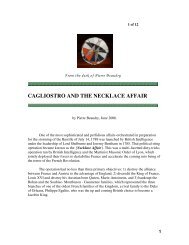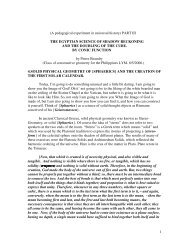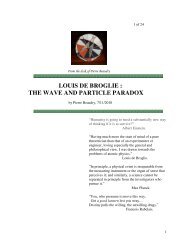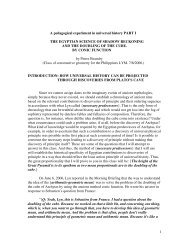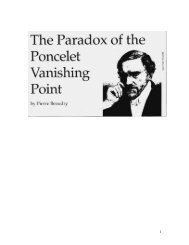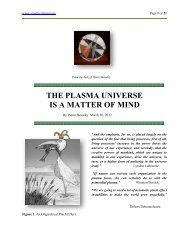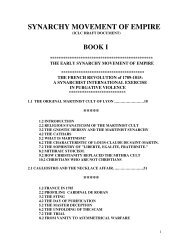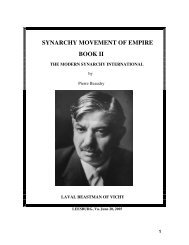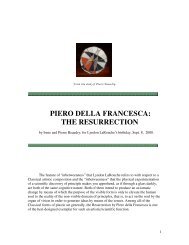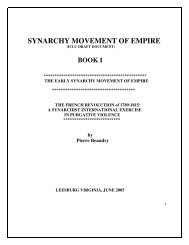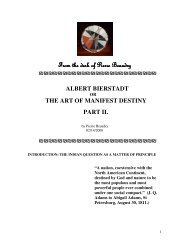filippo brunelleschi's mind and the catenary principle - Pierre ...
filippo brunelleschi's mind and the catenary principle - Pierre ...
filippo brunelleschi's mind and the catenary principle - Pierre ...
You also want an ePaper? Increase the reach of your titles
YUMPU automatically turns print PDFs into web optimized ePapers that Google loves.
4. THE CUPOLA, THE DOUBLING OF THE CUBE, AND THE GREAT PYRAMID.“The reason why you have difficulties in underst<strong>and</strong>ingnegative curvature is because it’s always in your face.”Dehors DebonneheureLet us get back, one last time, to <strong>the</strong> conceptual unity of effect in <strong>the</strong> construction of <strong>the</strong> pointedprofile of <strong>the</strong> cupola. Aside from being structurally <strong>and</strong> es<strong>the</strong>tically essential, <strong>the</strong> musical ratios for <strong>the</strong>inside <strong>and</strong> outside shells are <strong>the</strong> crucial key shadows of curvature of <strong>the</strong> cupola. The internal Gothic archratio of <strong>the</strong> quinto acuto (pointed fifth) was an absolute condition established in 1376 by <strong>the</strong> Wardens ofWorks. Brunelleschi had to abide absolutely by this criterion <strong>and</strong> used it as a guide function throughout<strong>the</strong> construction of <strong>the</strong> great work. Ironically, however, this criterion was of <strong>the</strong> same proportionality as<strong>the</strong> doubling of <strong>the</strong> cube discovered by Archytas <strong>and</strong> <strong>the</strong> same proportionality as found in <strong>the</strong> GreatPyramid of Egypt. Is this merely a coincidence or are we confronted, here, with a community of<strong>principle</strong>? Time will tell.The answer to that question might be found in <strong>the</strong> <strong>catenary</strong> property that reflects <strong>the</strong>transcendental function of inversion, since it is an architectonic <strong>principle</strong> which pulls new creative ideasfrom final causality into <strong>the</strong> real world. This iswhat Leibniz had also identified as aconstructive geometrical method that functionsby inversion of tangents. Here, this inversionprocess is best reflected by <strong>the</strong> increase inenergy flux-density from <strong>the</strong> Middle Age to <strong>the</strong>Renaissance; that is, <strong>the</strong> passing from a lowerform of existence to a higher form of existence.The construction of <strong>the</strong> Great Pyramidencountered a similar situation in AncientEgypt. Moreover, one also has to make anaxiomatic leap from <strong>the</strong> plane to <strong>the</strong> solid inorder to discover <strong>the</strong> proportionality for <strong>the</strong>Archytas doubling of <strong>the</strong> cube. Such inversionsare always necessary to go beyond whatappears to be impossible from <strong>the</strong> st<strong>and</strong>point ofprevious axiomatic st<strong>and</strong>ards. The same occursin any historical period of axiomatic change.Figure 9. Application of <strong>the</strong> Archytas doubling of <strong>the</strong> cube to <strong>the</strong> profile of <strong>the</strong> Great Pyramid of Egypt.The proportionality of <strong>the</strong> Great Pyramid profile <strong>and</strong> <strong>the</strong> Brunelleschi cupola are <strong>the</strong> same! Cube <strong>the</strong>indicated lengths of each of <strong>the</strong> four segments AB, AM, AP, <strong>and</strong> AC <strong>and</strong> you obtain a series of cubicvalues that are <strong>the</strong> doubles of one ano<strong>the</strong>r in <strong>the</strong> indicated proportionality.18




